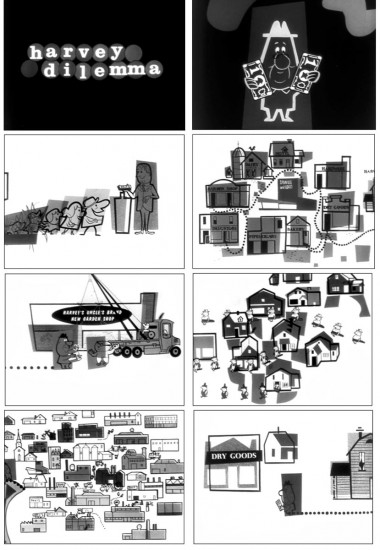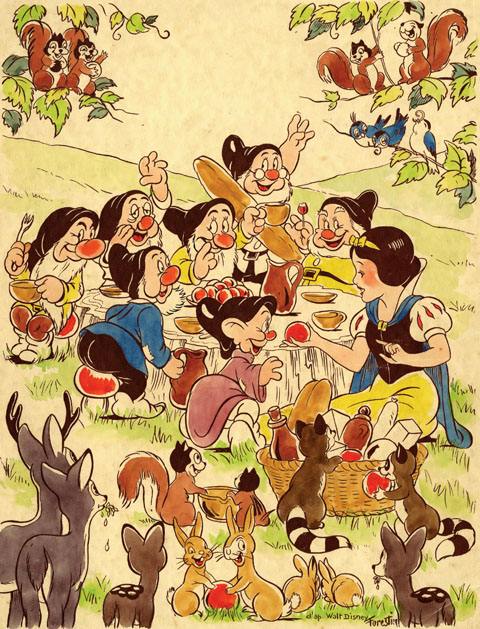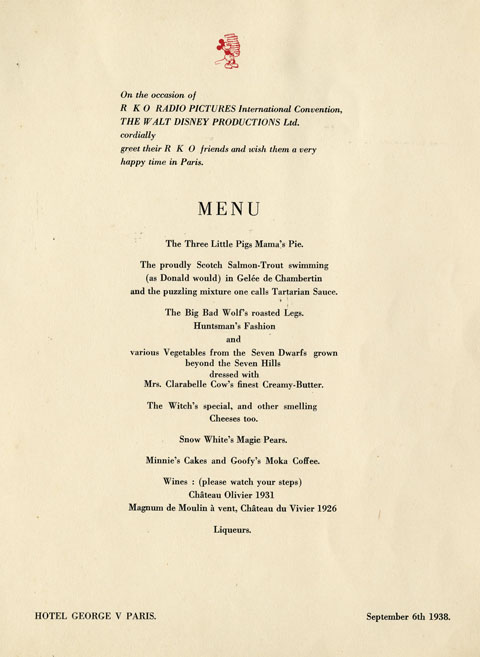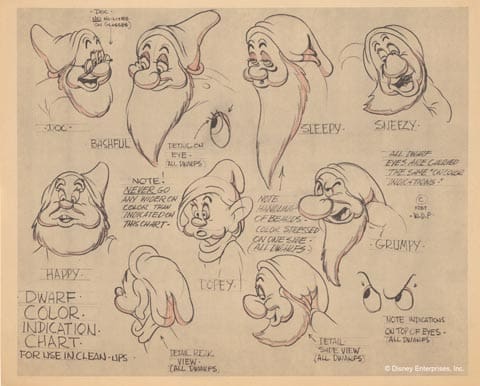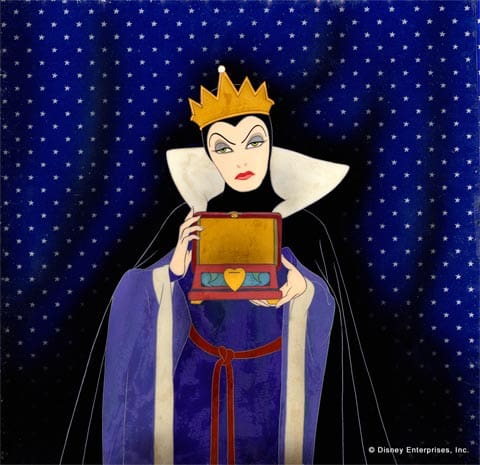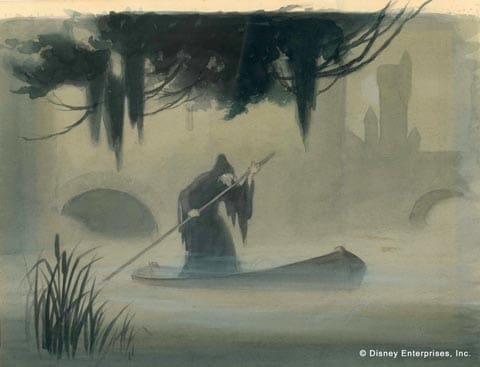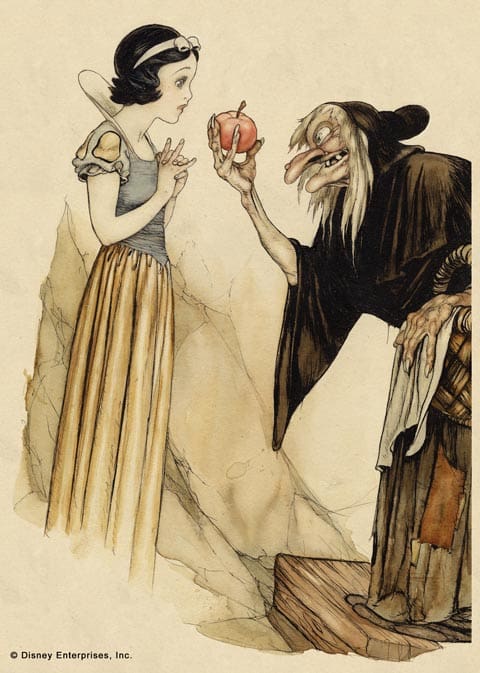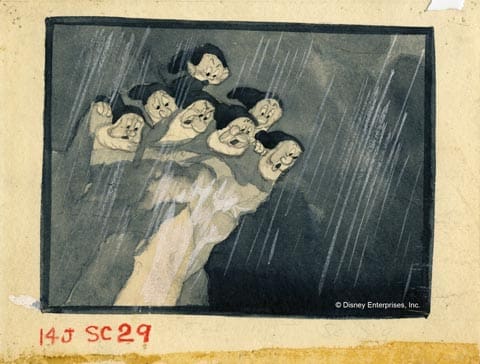"Inside Out" production designer Ralph Eggleston and historian John Canemaker will introduce some of the screenings.
Add a CommentViewing: Blog Posts Tagged with: Snow White and the Seven Dwarfs, Most Recent at Top [Help]
Results 1 - 11 of 11
Blog: Cartoon Brew (Login to Add to MyJacketFlap)
JacketFlap tags: Bambi, Museum of Modern Art, Fantasia, Technicolor, Walt Disney Studios, John Canemaker, Inside Out, Snow White and the Seven Dwarfs, Ub Iwerks, Chuck Jones, Ralph Eggleston, Nine Old Men, Melody Time, Josh Siegel, Theo Gluck, Wilfred Jackson, Events, Add a tag
Blog: Cartoon Brew (Login to Add to MyJacketFlap)
JacketFlap tags: RIP, Sleeping Beauty, Don Bluth, Snow White and the Seven Dwarfs, The Secret of NIMH, Ron Dias, Who Framed Roger, Add a tag
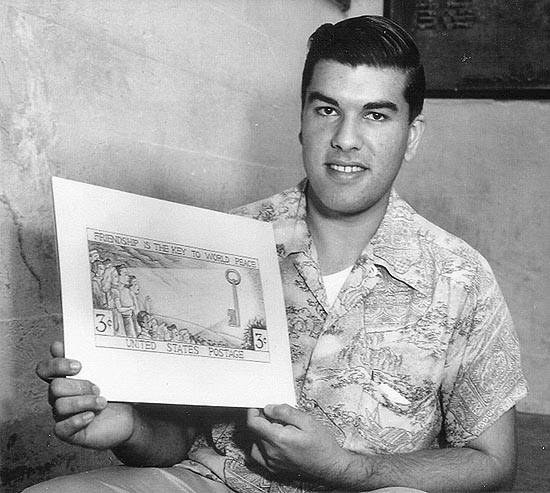
Background painter and stylist Ron Dias died in California on Tuesday, July 30th at the age of 76. Born in Honolulu, Hawaii on February 15, 1937, he first decided to pursue an art career after seeing Snow White and the Seven Dwarfs at the age of 6.
A graduate of the Honolulu Academy of Art and the correspondence art program Famous Artists School, he was hired at the Disney Studios in 1956 after winning a nationwide stamp contest. He explains his unlikely path into the animation world in this video interview:
Starting in the inbetween department during the production of Sleeping Beauty, this would be the beginning of a forty-plus year association with the Disney Company that included illustrating their characters for Golden Books, art directing limited edition cels for Disney Art Editions, art directing The Little Mermaid TV series and creating artwork for Disney’s interactive CD-ROMs in the 1990s.
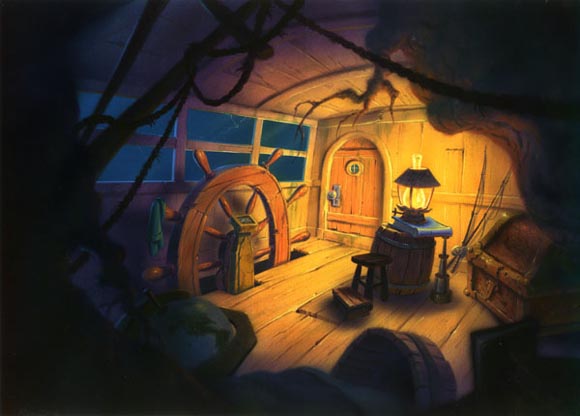
His background art was seen in the cartoons of many major studios during the animation industry’s silver age, including Hanna-Barbera (Hey There, It’s Yogi Bear, Jonny Quest, The Man Called Flintstone), DePatie-Freleng (The Pink Panther), Warner Bros. (Return of Duck Dodgers in the 24 ½ century), UPA (Uncle Sam Magoo) and Ralph Bakshi’s Lord of the Rings. He also worked as a color stylist on The Secret of NIMH (pictured above), Dragon’s Lair and Space Ace for Don Bluth, and the Toon Town sequence in Who Framed Roger Rabbit (below).
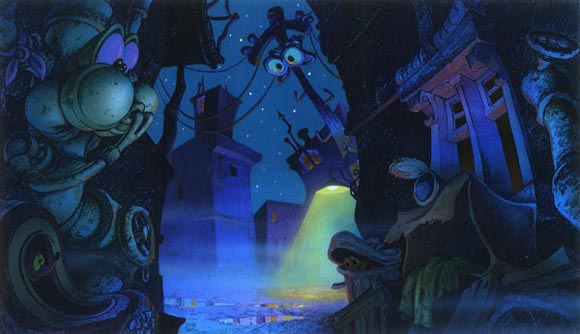
He retired to California’s Monterey Peninsula in 1999, focusing on fine art painting and advocacy for art in the school system. He is survived by his partner of thirty-five years, Howard, as well as two sons and three grandchildren. Go here to see a portfolio of Ron Dias’s artwork.
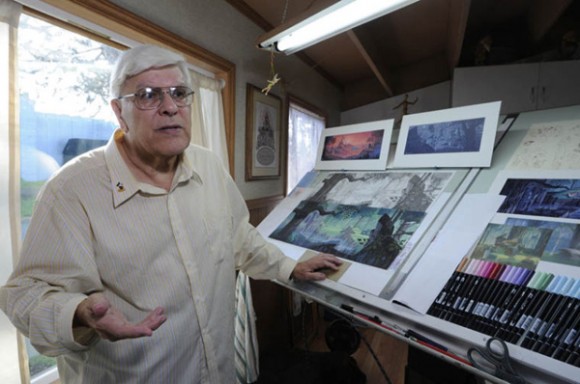
Blog: Cartoon Brew (Login to Add to MyJacketFlap)
JacketFlap tags: Bill Melendez, Ed Levitt, Disney, Animators, RIP, Peanuts, Bambi, Fantasia, Snow White and the Seven Dwarfs, Add a tag
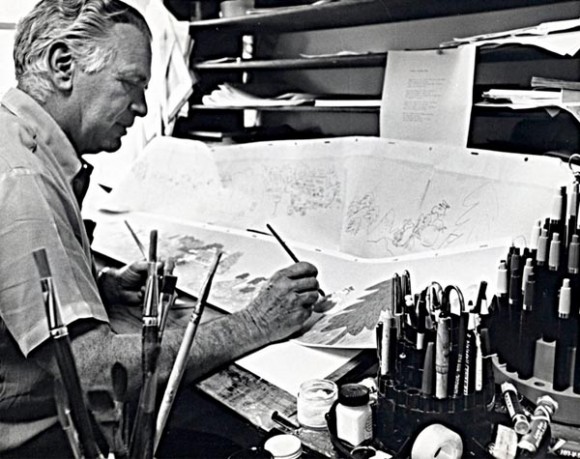
Edward Levitt, an unsung hero of the Golden Age of animation, has died. He was 96. Levitt died on Tuesday, April 2, in Palmdale, California.
Levitt worked as a production designer, storyboard and layout artist, and background painter for thirty-five years in the animation industry. His superb skills as a designer made him a key figure during the Cartoon Modern era of the 1950s.
Ed Levitt was born in New York City on April 17, 1916 and grew up in Somers, Connecticut and Brooklyn, New York. His family moved to Los Angeles in the mid-1930s and following graduation from high school, Levitt applied to the Disney Studios in 1937. He was hired at $16.50 per week and did rotoscape tracing on Snow White and the Seven Dwarfs.
The Disney studio recognized his talent as a painter, and by the end of production on Snow White, he had switched to painting backgrounds. He worked as a background artist on Pinocchio, the “Rite of Spring” segment in Fantasia and Bambi. Levitt picketed during the Disney strike of 1941. He returned after the strike was settled to work on Victory Through Air Power, but left again to enlist in the Marines in 1943. During the war, he made training films while a member of the Marine Corps Photographic Section in Quantico, Virginia.
Here are a couple examples of his paintings from Fantasia and Bambi:
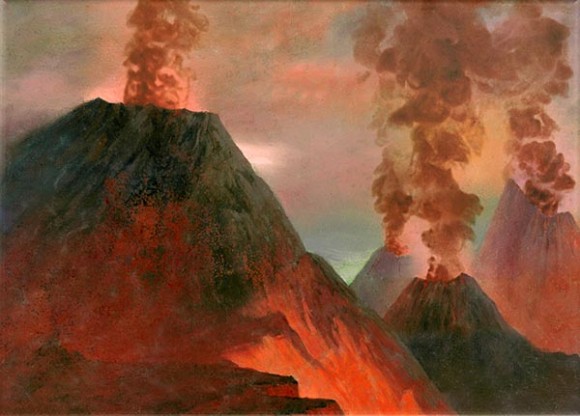
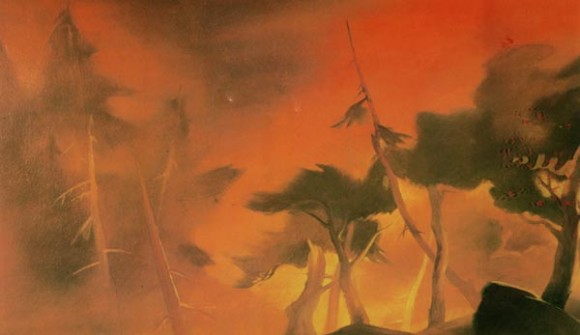
After the war, Levitt became a partner in a Los Angeles-based production company called Cinemette, which was formed with ex-Marines (and Disney artists) John Chadwick, Jack Whitaker, and Keith Robinson. The studio operated between 1946-1950, and they created a number of industrial films, as well as entertainment short subjects and early TV commercials.
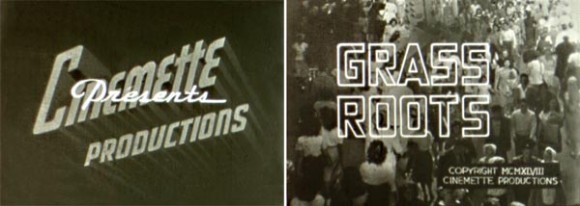
Levitt’s liberal politics led him to direct Grass Roots (1948), which called for establishing a world government through a revision of the United Nations charter and was partly funded by the United World Federalists. He also produced a popular anti-nuclear film Where Will You Hide? (1948), which attracted the attention of no less than Albert Einstein, who commented, “Somebody, after having seen this film, may say to you: This representation of our situation may be right, but the idea of world government is not realistic. You may answer him: If the idea of world government is not realistic, there there is only onerealistic view of our future: wholesale destruction of man by man.”
Levitt’s star rose during the 1950s when commercials and commissioned films were produced at an increasingly frenetic pace. His graphically accessible yet sophisticated style made him much sought after as a designer, storyboard and layout artist. “He was a great artist,” said animator Bill Littlejohn. “And his layouts were the best. He could animate, too. I sure liked working with him. He was so damn good at what he did. He knew the problems that the animators would face and he would design things with that in mind.”
These are a few examples of commercials and films designed and laid out by Levitt: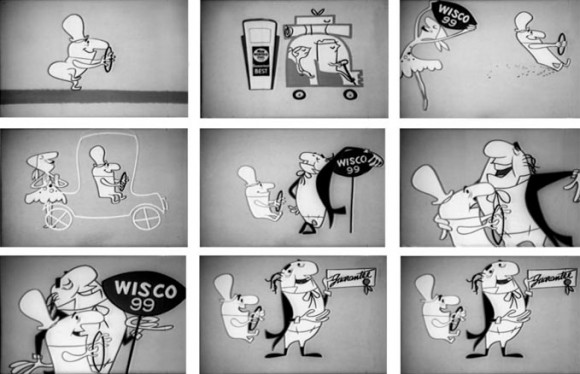
Through the 1950s, Levitt worked as a freelancer at more than a dozen studios including Graphic Films, Cascade Pictures, Raphael G. Wolff, Quartet Films, John Sutherland Productions, Eames Office, ERA Productions, United Productions of America, Ray Patin Productions, Academy Pictures, Churchill/Wexler Film Productions, Storyboard Inc., and Fred A. Niles Productions.
At Playhouse Pictures, Levitt worked closely with director Bill Melendez on many of the Ford spots starring the cast from the Peanuts comics. When Melendez opened his own studio in 1964, Levitt was one of the first artists he hired. “I remember Ed as being reliable, steady, pragmatic, kind and generous,” said Melendez’s son Steve, who also worked at the studio. “I know that he helped Bill in the early days not only artistically but also financially. Bill always considered Ed to be ‘The Best’, a title he did not bestow easily or often. Ed could draw anything and had a great grasp of how a film is made. He was the best layout person I have ever met.”
Levitt played a key role in designing the first Peanuts special, A Charlie Brown Christmas with backgrounds like this:
He also coined the famous credit used for many years at the end of the Peanuts specials—Graphic Blandishment. “Blandishment” is defined as “something that tends to coax or cajole,” which speaks to Levitt’s modesty and his view of the role he played in the filmmaking process.
Steve Melendez recalled that Levitt was proud of A Charlie Brown Christmas even during times of uncertainty and doubt:
“When we completed A Charlie Brown Christmas, and we all had a chance to look at the answer-print, Bill, Lee [Mendelson] and everyone else thought we were the authors of a great disaster and we would probably never make a film again. Ed was the sole voice who said, ‘Don’t be silly, this film will be shown for a hundred years!’ And he was right. I don’t know if he believed it or not, but his calm confidence gave everyone hope that perhaps things were not as bad as they seemed.”
By the early-1960s, Ed identified himself as a Cartoonist-Rancher on his income tax returns. He had begun taking animal husbandry classes at Pierce College, and had purchased a ranch in Lake Hughes, an hour’s drive north of Los Angeles, near Gorman, California. There, he planted cherry and apple orchards, and began to raise cattle.
Bill Melendez made this drawing of “cartoonist-rancher Ed”: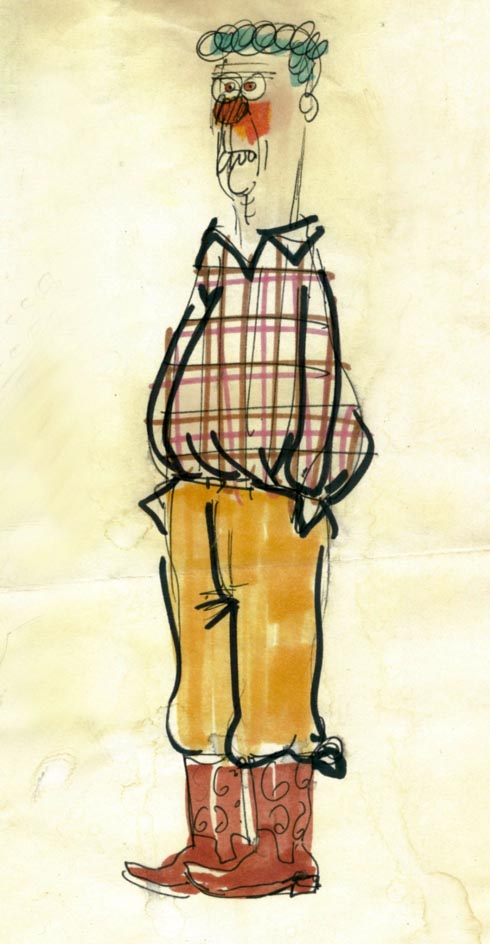
He spent most of the 1960s working on the Charlie Brown TV specials, and also directed a couple of Babar specials for Melendez. Other Sixties projects included the titles of It’s a Mad Mad Mad Mad World, and the features Gay Purr-ee and The Incredible Mr. Limpet.
Levitt retired from animation in 1973 to become a full-time rancher and orchard owner. “As you get older,” Levitt told a newspaper reporter, “it just seems a lot nicer to sit up here in the forest and listen to the trees grow.”
Levitt is predeceased by his wife, Dorothy. He is survived by his brother, Julius Levitt; sister, Annette Priemer; his four children, Alan Cyders; Geoffrey, Dan and Paul Levitt, along with numerous grandchildren and great-grandchildren. In lieu of flowers, the family has requested that donations be made in his name to the Motion Picture & Television Country House and Hospital.
Add a CommentBlog: Cartoon Brew (Login to Add to MyJacketFlap)
JacketFlap tags: Books, Events, Disney, Walt Disney, Snow White and the Seven Dwarfs, J. B. Kaufman, Walt Disney Family Museum, *Promote Video, Add a tag
Diane Disney Miller, author J.B. Kaufman and Lella Smith (creative director of the Disney Animation Research Library) discuss the art just published in Kaufman’s second new Snow White book, Snow White and The Seven Dwarfs: The Art and Creation of Walt Disney’s Classic Animation.
This second Snow White book by J.B. – not to be confused with The Fairest One Of All, both on sale today – is primarily an art book published in conjunction with The Walt Disney Family Museum’s new exhibit, Snow White and The Seven Dwarfs: The Creation of a Classic (opening November 15th and will run through April 14th 2013). This book walks the reader through the movie, scene by scene, accompanying the art with behind-the-scenes stories about the film’s production. I highly, highly recommend it!!
Add a CommentBlog: Cartoon Brew (Login to Add to MyJacketFlap)
JacketFlap tags: J. B. Kaufman, *Promote Video, Books, Disney, Snow White and the Seven Dwarfs, Add a tag
Perhaps the best book of animation history and Disney scholarship being published this year, The Fairest One Of All: The Making of Walt Disney’s Snow White and The Seven Dwarfs, will go on sale next week. I’ve seen it, I have it, I’ve read it… and I’m urging you to buy it. You will not be disappointed. The publisher produced this exclusive (to Cartoon Brew) promo clip featuring author J.B. Kaufman and Diane Disney Miller (she wrote the foreword) discussing the project. If this doesn’t whet your appetite, you are reading the wrong blog…
Add a CommentBlog: Cartoon Brew (Login to Add to MyJacketFlap)
JacketFlap tags: Disney, Bad Ideas, Noah Z. Jones, Snow White and the Seven Dwarfs, 7D, Alfred Gimeno, Disney Jr., Sherri Stoner, Tom Ruegger, TV, Add a tag
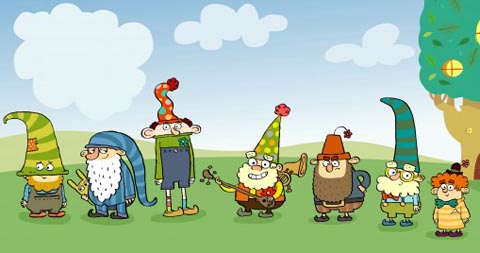
Have you ever wondered what Disney’s Seven Dwarfs would look like if the characters were designed by an artist who had no fundamental understanding of drawing, color theory or appeal? Wonder no more. The designs above, which look more like an animation student’s first pass in a character design class than functional designs for a TV series, will be used in a new Disney TV production called 7D, that will premiere on Disney Junior in 2014.
A bunch of Tiny Toons and Animaniacs alumni are involved: Tom Ruegger exec produces, Alfred Gimeno directs and Sherri Stoner story edits. Fish Hooks creator Noah Z. Jones designed the characters. He’s made it impossible to differentiate between the dwarfs, but I can only assume that turning them into generic icons was a directive from above.
According to Deadline:
Described as a comedic take on the world of Seven Dwarfs in a contemporary storybook world, 7D takes place in Jollywood where Queen Delightful relies on the 7D — Happy, Bashful, Sleepy, Sneezy, Dopey, Grumpy and Doc — to keep the kingdom in order. Standing in their way are two laughably evil villains, Grim and Hildy Gloom, who plot to take over the kingdom by stealing the magical jewels in the 7D’s mine.
Man, what I wouldn’t give for a couple of solid, well-constructed drawings just about now….
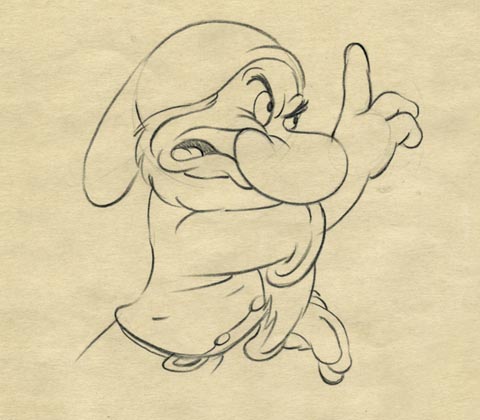
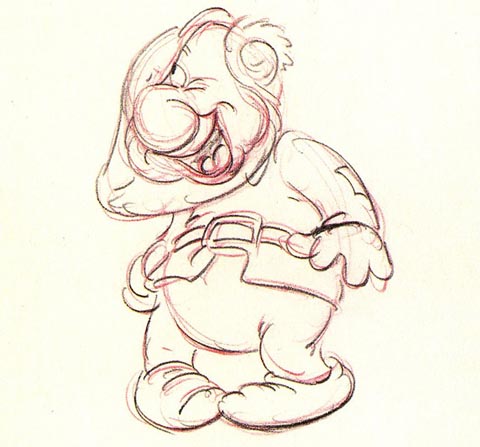
Aah…that’s better.
Cartoon Brew |
Permalink |
One comment |
Post tags: 7D, Alfred Gimeno, Disney Jr., Noah Z. Jones, Sherri Stoner, Snow White and the Seven Dwarfs, Tom Ruegger
Blog: Cartoon Brew (Login to Add to MyJacketFlap)
JacketFlap tags: Disney, Snow White and the Seven Dwarfs, Add a tag
Not pictured in that Animation Auction catalog we posted about last week is this extra piece that comes with the autographed Snow White storybook. It’s the menu (below, click to enlarge) for the private luncheon of 24 RKO execs at their international distribution convention in Paris, at the Hotel George V on September 6th, 1938.
I don’t know about you, but I wouldn’t mind getting my hands on Snow White’s Magic Pears or have a taste of Clarabelle Cow’s Creamy-Butter!
Cartoon Brew |
Permalink |
No comment |
Post tags: Snow White and the Seven Dwarfs
Blog: Cartoon Brew (Login to Add to MyJacketFlap)
JacketFlap tags: Disney, Classic, Feature Film, Gustaf Tenggren, Snow White and the Seven Dwarfs, Walt Disney Family Museum, Ken O'Connor, Sam Armstrong, Add a tag
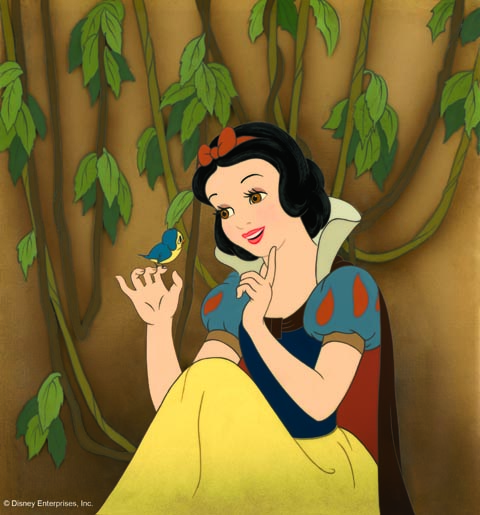
The Walt Disney Family Museum announced yesterday their first major special exhibition, “Snow White and the Seven Dwarfs: The Creation of a Classic.” The show is tied into the film’s 75th anniversary this year, and will be on view from November 15, 2012 through April 14, 2013 at the San Francisco-based museum.
I saw a preview of the exhibition yesterday afternoon and it will be a must-see for any Cartoon Brew reader. The more than 200 pieces of art on display will include conceptual drawings, early character studies, detailed story sketches, and animation drawings, as well as thumbnail layout watercolors, pencil layouts, watercolor backgrounds, cels, and vintage posters.
The show will be organized by sequence through the progression of the film, featuring plenty of never-before-seen artwork and behind-the-scenes stories about the film’s production. Artwork from deleted sequences like the Dwarfs’ Bed Buildng Scene and Snow White-dancing-in-the-stars fantasy segment will also be represented. The exhibition is curated by Lella Smith, the Creative Director of the Walt Disney Animation Research Library, and will be accompanied by an exhibition catalog written by J. B. Kaufman. (We’ve plugged the catalog earlier on Cartoon Brew.
Below is a preview of five of the pieces that will appear in the show. All images are ©Disney Enterprises, Inc. The watercolor concept of the witch in the rowboat was painted by Sam Armstrong; the witch offering Snow White the poisoned apple was drawn by Gustaf Tenggren; the layout thumbnail of the dwarfs looking over the precipice was drawn by Ken O’Connor. Click on any of them for a larger version.
Cartoon Brew | Permalink | No comment | Post tags: Gustaf Tenggren, Ken O'Connor, Sam Armstrong,
Add a CommentBlog: Cartoon Brew (Login to Add to MyJacketFlap)
JacketFlap tags: Books, Disney, Snow White and the Seven Dwarfs, J. B. Kaufman, Add a tag
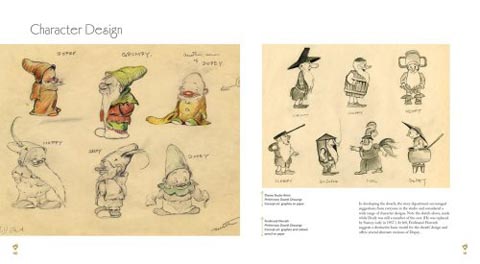
This is turning out to be quite the year for historical Disney animation books. We’ve already announced Pete Docter’s Nine Old Men flipbook series and my own biography Full Steam Ahead: The Life and Art of Ward Kimball. Now, available for pre-order are two different Snow White books, in honor of the film’s 75th anniversary, which is this December.
The first is The Fairest One of All: The Making of Walt Disney’s Snow White and the Seven Dwarfs, which is written by the incomparable J. B. Kaufman, author of Walt in Wonderland: The Silent Films of Walt Disney and South of the Border with Disney: Walt Disney and the Good Neighbor Program, 1941-1948. At a hefty 320 pages, this promises to be the final word on the production of that seminal Disney film.
The second volume, also by Kaufman, is Snow White and the Seven Dwarfs: The Art and Creation of Walt Disney’s Classic Animated Film. More of an art book, this serves as the catalog to a major Snow White art exhibit that will open this fall at the Walt Disney Family Museum in San Francisco. Both Kaufman books will be published in October.
Also, arriving in October: A Disney Sketchbook. I’m not quite clear about the contents of the book, but judging from the description, it sounds like there will be lots of Disney development artwork in it (hopefully, mostly unpublished):
Imagine if one sketchbook had been passed down through the decades from one Disney animator to the next, with each one making a contribution before leaving it in the talented hands of another artist. That idea was the inspiration for A Disney Sketchbook. The drawings contained within it represent the entire range of animation development, from the origins of ideas to fully conceived characters. Pencil studies of a much-younger Wendy and a serpentlike sea witch reveal the many imaginative iterations that animators create before they ultimately perfect every hero and villain. And comprehensive studies of Mickey and Baloo showcase the dedication that goes into defining the facial expressions and body language of each beloved character. Films and shorts from throughout the history of the company are featured—beginning with Steamboat Willie and ending with Tangled—demonstrating the ingenuity and skill that have remained a constant at Walt Disney Animation Studios since 1928.
Add a Comment
Blog: Cartoon Brew (Login to Add to MyJacketFlap)
JacketFlap tags: Illustration, Disney, Gyo Fujikawa, Snow White and the Seven Dwarfs, Add a tag
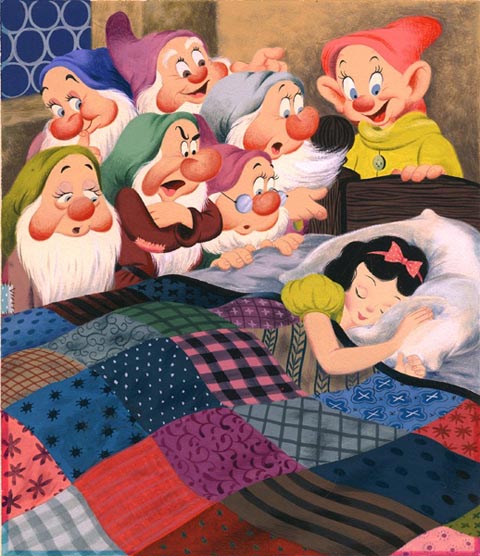
This appealing, exquisitely colored 1952 magazine illustration of Snow White and the Seven Dwarfs by children’s book illustrator Gyo Fujikawa will be auctioned next week at the Illustration House. Fujikawa worked briefly at the Disney animation studio before she moved to New York to pursue a career in advertising and illustration. The auction estimate for the painting is $5,000 to $7,000.
Cartoon Brew: Leading the Animation Conversation |
Permalink |
No comment |
Post tags: Gyo Fujikawa, Snow White and the Seven Dwarfs
Blog: Cartoon Brew (Login to Add to MyJacketFlap)
JacketFlap tags: Snow White and the Seven Dwarfs, Disney, Add a tag
Here’s one for you Disney historians and cartoon musicologists. Brew reader Eric Graf has made a remarkable find which I hadn’t heard (literally!) before. I’ll let Eric, in his own words, share his research with you. Says Eric:
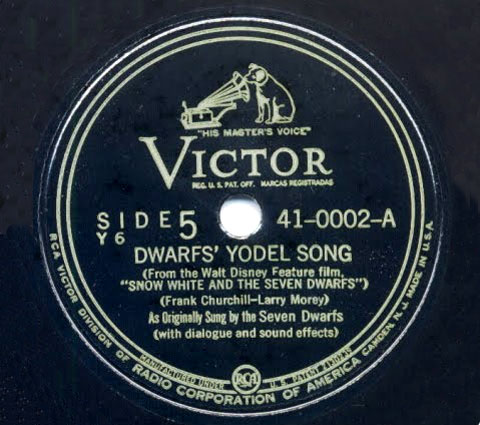
“Yesterday I found a 78 that I’d been searching for for years … the Victor Records soundtrack of the Dwarfs’ Yodel Song (aka “The Silly Song”) from Snow White and The Seven Dwarfs.
“Here’s the story as I understand it: Snow White was banned in Boston (and a few other cities IIRC) because of a verse in the Yodel Song that was supposedly off-color. Disney removed it from the Boston prints, and at some point also removed it from all the other versions of the movie.
“Since then Disney’s gone out of their way to pretend it never happened. It’s not included, or even mentioned, on any home video release I’m aware of, and it also isn’t on the Disney Snow White soundtrack CDs. But it WAS included on side 5 of the soundtrack album released by Victor Records in early 1938.
“My copy hails from the mid-40s, but it’s pressed from the original 1938 metal parts. The deleted verse is the one Sneezy sings starting at 1:04. It’s not off-color by today’s standards. Maybe a little unsanitary though… (Click to play embed sound file below)
“But here’s something else interesting, that I discovered while syncing up the 78 with a YouTube video of the song (Feh, wrong aspect ratio): The 78 is missing the dwarf’s vocals on the choruses.
“The chorus at :52, which starts with Snow White giggling, doesn’t match the backing track that’s in the movie (YouTube 1:09), but it does match the animation WAY better than the current version – if you ignore the singing dwarfs in the background. Snow White is obviously giggling on-screen (a perfect match to the 78), and the drum thing fits beautifully with Happy’s dance. On the current soundtrack – no giggling, no drum thing. But they’re singing.
“Then you get to the second sung chorus (at 1:51 on both the record and YouTube) – and the dwarf’s mouths aren’t moving! The onscreen dwarfs start singing at 1:59 with the yodeling – which is where they start on the 78 as well.
“The mid-50s Disneyland LP issue of the Snow White soundtrack matches the current version. Therefore, my inner Sherlock maintains that the 78 is the original mix, and that the vocals were left out of the movie by accident. They fixed the mistake at some point, but then they made another mistake – which still stands today – when they added vocals to the other chorus as well.”
Cartoon Brew: Leading the Animation Conversation | Permalink | No comment |
Add a Comment



